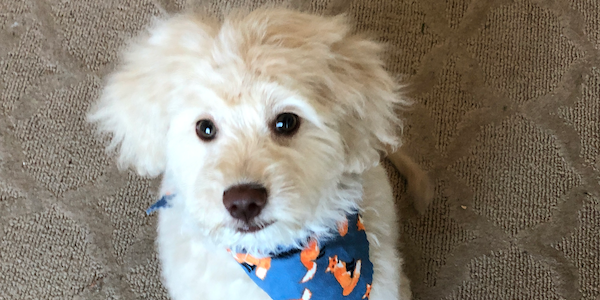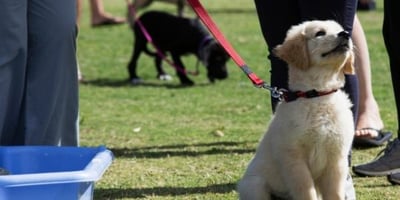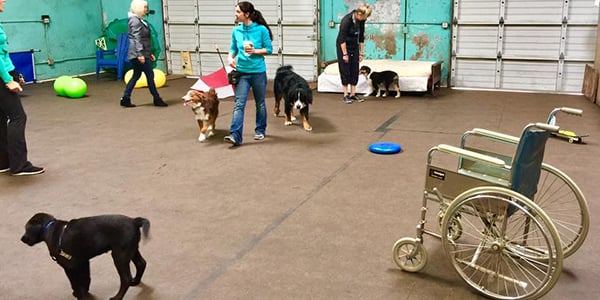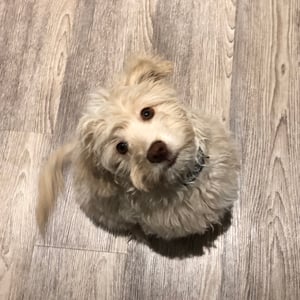 If you have a puppy, you know that their attention spans are quite ... short. Very, very short. A leaf may blow by and chasing it is all their brain can think about. But that's totally normal for a puppy!
If you have a puppy, you know that their attention spans are quite ... short. Very, very short. A leaf may blow by and chasing it is all their brain can think about. But that's totally normal for a puppy!
Even adult dogs have shorter attention spans than you may assume. While it's exciting to start training new skills or tricks with your dog, it can be frustrating to have them ignore you or only do a few repetitions before wanting to do something else.
For overall better training and to keep things fun for you and your dog, keep your training sessions short and sweet! This is especially important for young puppies, to ensure they find training with you a positive experience.
Signs of Training Fatigue in Dogs
Training for too long at one time can cause your pup to burn out. This is called training fatigue. We experience training fatigue as well — how does your brain feel after sitting in a class for hours at a time? Signs of training fatigue in dogs include:
-
Loss of interest in what you're doing together
-
Taking longer to respond to cues
-
No longer interested in treats or toys
- Increased nipping in puppies
-
Displacement behaviors (e.g., sniffing, yawning, shaking off)
If you notice any of these behaviors during your training session, it's crucial to take a break. Walk your dog around, give them a chew or stuffed puzzle feeder to work on, or even end the session for the day if they are just not into it. Do not rush training at the expense of your dog's trust.
You'll also want to consider whether it was just too long of a training session or if there was another reason they were struggling. Were you practicing in a new environment? Too many distractions? Was your dog already tired to begin with or perhaps not feeling well? Just like we have many variables that affect our willingness to do certain activities, so does your dog. Knowing what could be bothering them goes a long way in setting them up for an easier training session next time.
 How Long Should Dog Training Sessions Be?
How Long Should Dog Training Sessions Be?
You can set your pup up for success by committing to shorter training sessions. The magic number is about 3 to 4 minutes per skill session. For example, practice teaching your dog to lie down for a few minutes after you put your lunch in the microwave or during a television commercial break. Then a few hours later, practice some recall games after their usual potty break. Get more ideas for daily dog training opportunities here.
You can do lots of mini-training sessions throughout the day, rather than trying to get all your training done at one time. It’s easier on your puppy’s brain, and much easier on your daily schedule. Setting aside a few minutes throughout your day is more realistic than trying to block out an hour for dog training. This also gives your puppy’s brain time to digest the new information they’ve learned.
The magic number is 3 or 4 minutes per training session
But What About Dog Training Classes?
If you've signed your puppy up for a training class, you might be wondering how beneficial it will be if it's an hour long. A well-run puppy class will likely intersperse training exercises with "settle practice" (a.k.a. just relaxing on their mat or bed) and playtime with other puppies for socialization. Choose a puppy class that makes sure to set your pup up for success and full "absorption" of the training.
 Here's an example of how I intersperse my puppy classes with rest and play (the above photo is from one of my puppy classes):
Here's an example of how I intersperse my puppy classes with rest and play (the above photo is from one of my puppy classes):
- 5 minutes of warm-up with pattern games and name recognition practice
- 10 minutes of puppy play
- 5 minutes of training
- 10 minutes of puppy play
- 10 minutes of discussion while puppies practice settling on mats
- 5 minutes of training
- 5 minutes of chew time or snuffle mats
- 10 minutes of discussion/training
If you have an adult dog, the training classes won't include playtime but should include breaks where your dog isn't actively working for longer than a few minutes at a time. The dogs may go one by one, allowing the others to take breaks, or the trainer might have them relax while they cover the next training exercise and discuss how it will be done. But in all dog training classes, it is completely normal for dogs to be pretty burnt out by around 45 minutes in. Take that into consideration when practicing skills and make sure to manage your expectations.
Keep It Sweet: Dog Training Should Be Fun and Positive
Now that you’ve set yourself up for success by focusing on doing short training sessions, focus on having fun when training your dog. Not only will this make your dog happy to engage with you, but it will make you more motivated to train as well! Celebrate your dog’s successful behaviors, and don’t focus on the small mistakes they might make.
Positive reinforcement is a powerful tool. When your pup experiences positive feedback for a behavior, they're more likely to repeat it in the future. It's a win-win situation: you get the behavior you want, and your pup gets rewarded for doing it. However, if training sessions go on for too long, the resulting frustration can lead to feelings of negativity, which can undo all the positive effects of training. Frustration kills motivation, for us and our dogs.
Dog Training Expectations
Many dog owners are under the impression that their dog should completely learn the behavior before they quit the training session. This is simply not true. Many cues have multiple steps. For example, when training the “go to bed” cue, you’ll work on a chain of behaviors to get to the desired end behavior — starting with getting your dog to put one paw on their bed, and ending with them staying on their bed. Even with non-complex behaviors, it still takes time and repetition for a puppy to build fluency.
 When working on "leave it" with any dog, I’m making sure to not make it too hard, too fast. This way they have lots of successful repetitions before moving on to the next, more difficult, step. I don’t expect them to be able to leave a piece of chicken alone when it falls off the kitchen counter on the first day since I haven’t practiced that level of difficulty yet.
When working on "leave it" with any dog, I’m making sure to not make it too hard, too fast. This way they have lots of successful repetitions before moving on to the next, more difficult, step. I don’t expect them to be able to leave a piece of chicken alone when it falls off the kitchen counter on the first day since I haven’t practiced that level of difficulty yet.
You cannot blame a dog for doing completely normal dog behaviors if you have not invested the time in teaching them how not to do it in the first place.
For leave it, I start with a stationary low-value piece of food in my hand that a dog has to leave alone, then slowly raise the criteria by placing the treat on the floor, dropping it on the floor, then rolling it on the floor. Once she has these, we can train with higher-value treats or "treats" like wrappers she likes to pick up on our walks. See the whole process of teaching your dog to "leave it" here.
Set Reasonable Expectations
Manage your expectations — don’t set the bar so high that your pup has little chance of succeeding. Break skills down into multiple easy steps and do daily practice. Training is a journey.
Your expectations are too high if you expect your dog to be able to get it in one training session. Not only does this set you up for failure, but you and your dog will also likely be frustrated by the end and less likely to want to try again later.
Behaviors take time to learn; your dog will learn faster with short sessions and positive repetitions.
Watch this video to see Preventive Vet pup, Mary Berry, practice Leave It and a Sit-Stay at the door in short training sessions:
Follow Training with Play
It's always a good idea to follow any training with a short play session if your pup is interested. In fact, studies have confirmed that dog-human play after training improves a dog's memory. It's a great way to build your relationship and release some stress. A dog's love of play is one of the many reasons we get along with them so well.
So grab a tug toy, fetch stick, or flirt pole, and have some fun with your dog. Check out this video of puppy Finnegan, a Portuguese Water Dog, playing tug and learning how to drop it at the same time:
More Training Resources for Puppies:
- Take Advantage of Daily Dog Training Opportunities
- How Many Treats You Can Give Your Dog During Training
- Dog Training Aversives: What Are They and Why Should You Avoid Them?
- When to Start Socializing Your New Puppy
- The Right Way to Stop Your Puppy From Nipping and Biting



